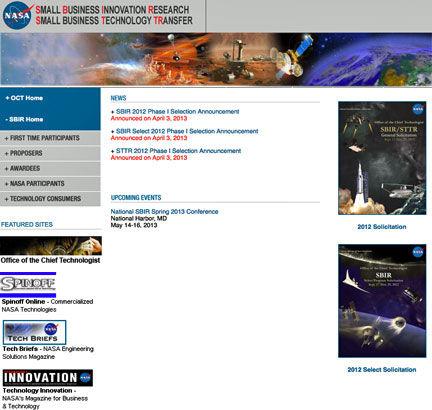 [SatNews] NASA has selected 295 research and technology proposals from 216 American small businesses for...
[SatNews] NASA has selected 295 research and technology proposals from 216 American small businesses for...
...negotiations that may lead to contract awards worth a combined $38.7 million. The proposals are part of NASA's Small Business Innovation Research Program (SBIR) and Small Business Technology Transfer (STTR) Program.
SBIR addresses specific technology gaps in agency missions while striving to complement other agency research investments. Numerous NASA efforts, including modern air traffic control systems, Earth-observing spacecraft, human spaceflight and the International Space Station, and NASA's Mars rovers have benefited from the program. The STTR program additionally facilitates the transfer of technology developed by a research institution through the entrepreneurship of a small business.
"NASA's small business innovation research projects are strong and valuable investments that continue to pay dividends to NASA and the American people," said Michael Gazarik, NASA's associate administrator for space technology in Washington. "If successful, these early stage technology concepts will mature to meet NASA's mission needs while also providing solutions that have wide applicability in the marketplace, potentially becoming new products, services and jobs here in the U.S."
This year, NASA issued two concurrent solicitations for Phase I proposals. A general solicitation for both SBIR and STTR sought Phase I proposals in response to a broad range of research topics. A select solicitation was for the SBIR program only and focused on a small group of topics of particular interest to the agency.
Innovative research areas among these selected proposals include:
The highly competitive SBIR-STTR program is a three-phase award system. Phase I is a feasibility study to evaluate the scientific and technical merit of an idea. Awards typically are for six months for the SBIR contracts and 12 months for the STTR contracts. The maximum amount is $125,000 for general SBIR and STTR contracts and $200,000 for SBIR select solicitation proposals. Firms successfully completing Phase I are eligible to submit a Phase II proposal, expanding on the results of the developments in Phase I. Phase III is for the commercialization of the results of Phase II and requires the use of private sector or non-SBIR federal funding. For the general SBIR Phase I solicitation, NASA selected 236 proposals worth about $29.4 million. For the select SBIR Phase I solicitation, NASA selected 26 proposals worth about $5.1 million. NASA selected 33 proposals with a value of about $4.1 million for STTR Phase I projects. The three solicitations attracted proposals from 32 states. Selection criteria included technical merit and feasibility, along with experience, qualifications and facilities. Additional criteria included effectiveness of the work plan and commercial potential and feasibility.
NASA's Ames Research Center at Moffett Field, California, manages the SBIR program for NASA's Space Technology Mission Directorate. NASA's 10 field centers manage individual projects.

